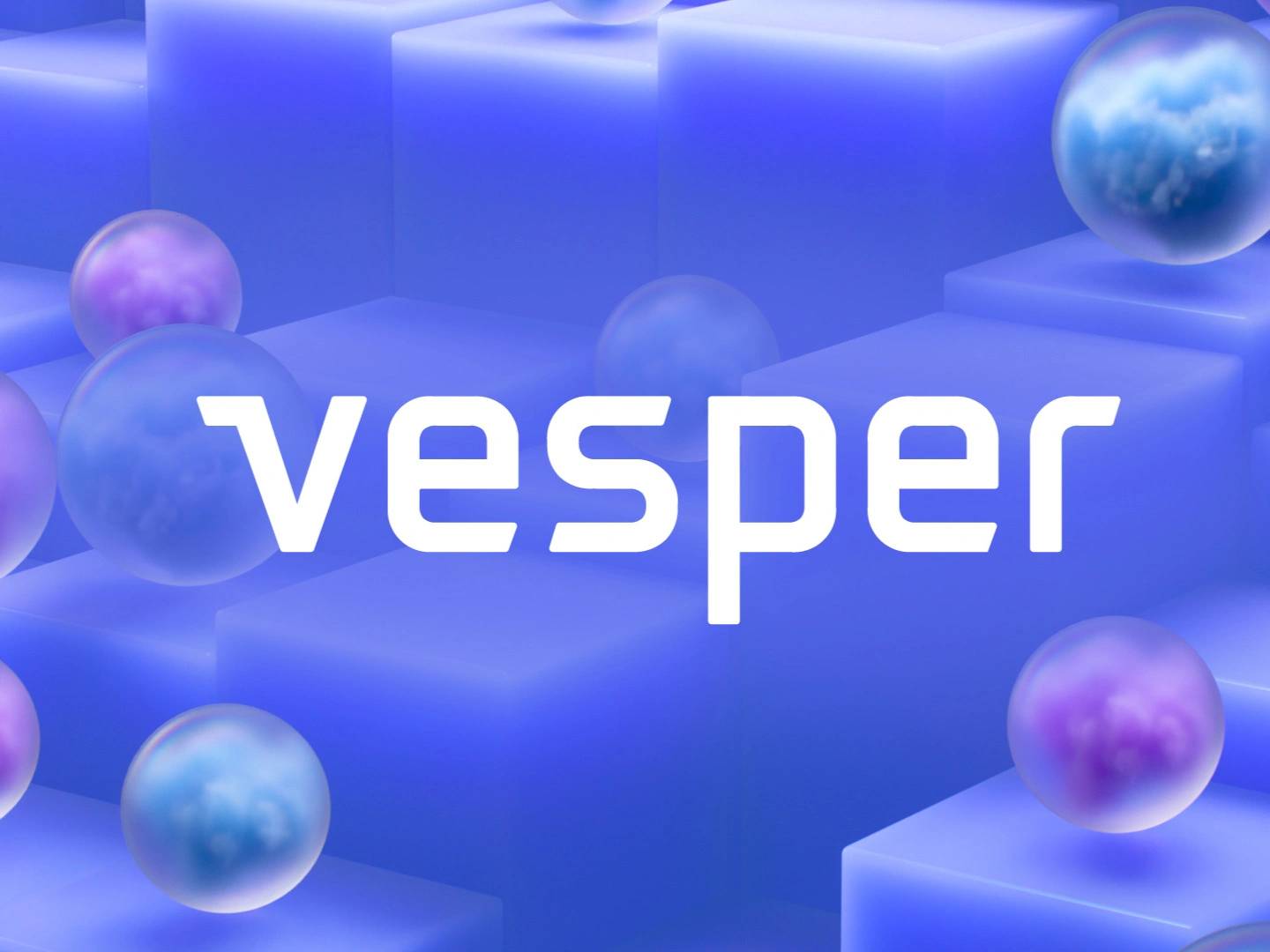Vesper Finance
Vesper Finance는 사용자 친화적인 경험에 중점을 둔 탈중앙화 금융 (DeFi) 프로토콜로 운영됩니다. Vesper 생태계의 핵심은 Vesper의 기능과 커뮤니티 발전에 중요한 역할을 하는 토큰인 Vesper 토큰 (VSP)입니다. Vesper가 제공하는 DeFi 상품은 사용자에게 수동적 소득을 창출하도록 설계되었습니다. [1][2]
개요
Vesper 프로젝트는 접근 가능한 수익 생성 전략, 인센티브 토큰(Vesper 토큰 또는 VSP), 그리고 커뮤니티 프레임워크라는 세 가지 핵심 요소를 중심으로 구성됩니다. VSP는 참여, 거버넌스 및 커뮤니티 참여를 가능하게 합니다. 이 플랫폼은 수동적 소득을 창출하기 위해 공격성과 자산 보유량이 서로 다른 다양한 이자 수익 전략을 제공합니다. Vesper는 사용자 편의를 위해 DeFi 환경을 간소화하는 것을 목표로 하며, 안전을 위해 수익 생성 전략에 대한 독립적인 감사가 수행됩니다. [2][3]
주요 구성 요소 및 서비스
베스퍼 풀 (Vesper Pools)
베스퍼 풀은 베스퍼 생태계의 중추 역할을 하며, 다양한 예치자들의 토큰을 통합하여 참여자들에게 수익을 창출합니다. 이러한 풀링된 자산은 적극적으로 대출, 차입 및 수익 농사에 사용됩니다. 각 풀은 예치 자산 및 수익 자산의 유형, 배포 전략 및 관련 위험 프로필을 포함하여 고유한 특성을 가지고 있습니다. 사용자는 원하는 자산과 위험 허용치에 맞는 풀을 선택할 수 있습니다. 또한, 일부 풀은 베스퍼의 네이티브 토큰인 VSP 보상을 제공하여 참여에 대한 추가 인센티브를 제공합니다. [4]
v토큰
v토큰은 베스퍼 풀(Vesper Pools) 생태계의 필수 요소이며, 풀에 담긴 자산에 대한 사용자의 지분을 나타냅니다. 예치된 토큰에서 v토큰으로의 전환율은 풀의 종류에 따라 다릅니다. 예를 들어, 성장형 풀(Grow Pools)에서는 풀이 수익을 축적하고 자산을 더 많이 확보함에 따라 v토큰의 가치가 증가합니다. 이러한 메커니즘을 통해 사용자는 자산의 복리 성장 혜택을 누릴 수 있습니다. 그러나 시간이 지남에 따라 가치가 상승하므로 초기 전환 비율이 1:1이 아닐 수 있습니다. [4]
수수료
Vesper는 운영 첫해에 출금 수수료와 플랫폼 수수료를 부과했습니다. 2022년 4월 기준으로 이러한 수수료는 통합 수수료 체계로 전환되었습니다. 통합 수수료는 재조정 시점에 예치된 자산에 대해 연 2%의 수수료를 부과하며, 이는 획득 수익의 50%로 상한이 설정됩니다. [4]
VSP 보상
특정 풀은 추가 VSP 보상을 제공하며, 사용자는 이를 자유롭게 청구하고 사용할 수 있습니다. 일반적인 방법 중 하나는 Vesper 거버넌스 풀에 VSP를 예치하여 vVSP로 전환하는 것으로, 이를 통해 거버넌스 의사결정에서 사용자의 투표력이 향상됩니다. VSP는 다른 DeFi 활동의 담보로도 사용될 수 있습니다. [4]
수익률
수익률은 종종 수익 또는 APY(연간 수익률)이라고 하며, 풀의 자산이 생성하는 기본 수익률과 VSP 보상의 두 가지 구성 요소의 합입니다. 수익률은 각 풀마다 다르며 Vesper 앱에 표시됩니다. [4]
재조정 프로세스는 Vesper 풀 내에서 수익 배분에 중요하며, 풀이 목표 담보율을 유지하도록 합니다. 재조정은 네트워크 혼잡 및 풀의 총 가치 잠금(TVL)의 영향을 받으며, 더 작은 풀과 더 비용이 많이 드는 전략은 가스 효율을 최적화하기 위해 재조정 빈도가 낮습니다. [4]
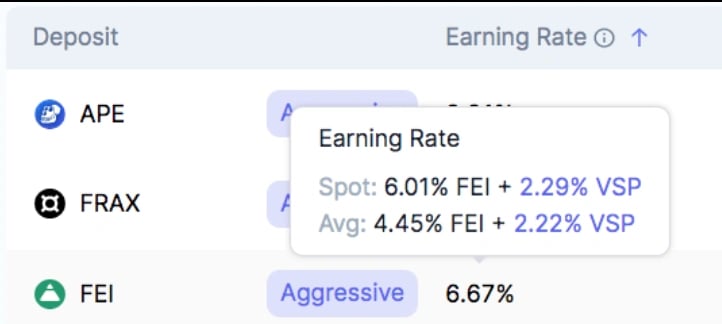
베스퍼 풀의 종류
베스퍼는 다양한 유형의 풀을 제공하며, 각 풀은 특정 사용자의 선호도와 목표에 맞춰 설계되었습니다.[4]
- 베스퍼 그로우 풀(Vesper Grow Pools): 이 풀은 특정 자산을 모아 적극적인 전략에 따라 사용합니다. 생성된 수익은 예치된 자산을 더 많이 확보하는 데 사용되므로 풀 참여자에게 이익이 됩니다.
- VSP/vVSP 거버넌스 풀(VSP/vVSP Governance Pool): 사용자는 이 풀에 VSP를 예치할 수 있으며, 모든 베스퍼 제품의 수익은 시장에서 VSP를 재매입하는 데 사용됩니다. 예치자는 예치 규모에 비례하여 VSP 이자를 얻습니다.
- 베스퍼 언 풀(Vesper Earn Pools): 이 풀은 그로우 풀과 유사하게 운영되지만 예치된 자산과 다른 자산을 수익으로 제공하여 DeFi의 새로운 개념을 도입합니다.
- 베스퍼 렌드 풀(Vesper Lend Pools): 베스퍼 렌드는 맞춤형 대출 플랫폼을 통해 암호 자산 대출을 용이하게 하여 안전하게 얻을 수 있는 최고 수익률을 달성합니다.
- 베스퍼 오비트 풀(Vesper Orbit Pools): 이 풀은 새롭고, 잘 알려지지 않은 자산 및 프로토콜을 다루어 더 높은 수익률을 창출하는 것을 목표로 하며, 잠재적으로 더 높은 수익을 제공합니다.
베스퍼 그로우 풀 (Vesper Grow Pools)
베스퍼 그로우 풀을 이용하면 다양한 DeFi 수익률 소스를 통해 예치금을 라우팅하여 보유량을 늘릴 수 있습니다. 하나의 자산을 예치하고 보수적인 전략과 공격적인 전략을 사용하여 동일한 자산을 더 많이 얻을 수 있습니다. 이 풀은 추가 대출 및 대출 환불 기준이 다른 알고리즘 대출 재조정을 사용합니다. 보수적인 풀은 공격적인 풀보다 위험이 낮습니다. [5]

베스퍼 Earn 풀
베스퍼 Earn 풀은 사용자가 예치한 자산과 다른 자산으로 수익을 얻을 수 있는 독특한 방식을 제공합니다. 주요 차이점은 수익이 예치된 자산과 다른 자산으로 발생한다는 점으로, DeFi에서 새로운 개념을 제시합니다. 이러한 풀은 다른 베스퍼 풀과 유사한 프로세스를 따르지만 자산 및 수익 토큰 페어링 측면에서 차별화됩니다. [6]
베스퍼 오비트(Vesper Orbit)
2021년 11월, 베스퍼 DAO(Vesper DAO)는 베스퍼 풀의 새로운 종류인 베스퍼 오비트(Vesper Orbit) 생성을 승인했습니다. 베스퍼 오비트(Vesper Orbit)의 주요 목표는 새로운 토큰과 프로토콜을 베스퍼의 자동 투자 상품에 통합하여 더 높은 수익률을 추구하는 것입니다. 베스퍼 오비트(Vesper Orbit)에서 사용하는 풀과 전략은 모든 베스퍼 상품에 적용되는 동일한 정책을 준수합니다. 그러나 베스퍼 오비트(Vesper Orbit) 상품은 검증되지 않은 새로운 자산과 프로토콜에 중점을 두고 있기 때문에 본질적으로 더 높은 위험을 수반합니다. [7]
주요 기능
- 보편적인 수수료: 다른 Vesper 제품들과 마찬가지로 Vesper Orbit 풀은 재조정 시점에 예치된 자산에 대해 연 2%의 수수료를 부과합니다. 이 수수료가 얻은 수익의 50%를 초과하는 경우 수익의 50%로 상한이 설정됩니다.
- Vesper Orbit 보상: Vesper Orbit 참여자는 언제든지 청구할 수 있는 VSP 보상을 받을 수 있습니다. 초기 Orbit 풀 배치에는 이러한 신제품을 홍보하기 위해 각각 1,250 VSP가 추가됩니다. 추가 VSP 할당은 대표 토큰 커뮤니티의 기여와 개별 풀 성과를 기반으로 합니다. 풀의 보상 계정에 새로운 VSP가 추가되면 문서가 업데이트됩니다.
- 전략 업데이트: Vesper Orbit은 Vesper 사용자에게 유망한 전략과 자산을 제공하는 데 중요한 역할을 합니다. 이러한 풀의 성공과 TVL(총 예치 가치)이 증가함에 따라 기본 Vesper 앱으로 "졸업"될 수 있습니다. 이러한 상태 변경은 기본 코드 변경 없이 풀의 인식된 안전성을 나타냅니다. 이러한 전환의 예로는 Orbit에서 시작하여 기본 Vesper 앱으로 "졸업"된 DPI 풀이 있습니다.[7]
베스퍼 오비트에 새로운 토큰 추가하기
베스퍼 오비트 제품군에 토큰과 프로토콜을 추가하는 것은 베스퍼 DAO의 투표를 통해 결정됩니다. 공식 투표 전에는 주로 베스퍼 디스코드 채널에서 커뮤니티 논의가 이루어집니다. [7]
멀티체인 및 크로스체인 배포
멀티체인 접근 방식
베스퍼의 아키텍처는 이더리움(Ethereum), 폴리곤(Polygon), 아발란체(Avalanche), 옵티미즘(Optimism)과 같은 여러 블록체인 플랫폼에서 계약을 마이그레이션할 수 있도록 설계되었습니다. 장기적인 목표는 이더리움 가상 머신(EVM) 모델에서 벗어나는 새로운 프로토콜에 대한 지원을 확장하는 것입니다. [8]
폴리곤과 아발란체의 베스퍼 풀
베스퍼는 특히 자원이 제한된 사람들이 DeFi에 참여하지 못하도록 하는 이더리움 네트워크의 높은 수수료 문제점을 인식하고 있습니다. 접근성을 높이기 위해 베스퍼는 자체 VSP 토큰과 다양한 Grow 풀을 폴리곤과 아발란체 네트워크에 배포했습니다. 또한 베스퍼 커뮤니티는 폴리곤을 포함한 다양한 체인과 레이어 2 (L2) 플랫폼을 지지하는 거버넌스 제안에 참여했습니다. [8]
사이드체인의 베스퍼 풀은 이더리움 메인넷의 풀과 동일한 스마트 계약 코드를 사용하지만, 수익률 원천과 결과적으로 수익률은 다를 수 있습니다. [9]
몇몇 베스퍼 Grow 풀은 참여자들에게 VSP 토큰 형태의 인센티브를 제공하여 기본 자산 수익률을 높입니다. 서로 다른 블록체인의 VSP 보상은 이더리움의 동등한 Grow 풀에 적용되는 일정과 항상 일치하지 않을 수 있으며, 이러한 보상은 주기적으로 조정될 수 있습니다. [10]
Vesper 모듈형 풀 (Modular Pool)
Vesper는 스마트 계약 관리자의 유연성과 적응력을 높이기 위해 모듈형 다중 풀 아키텍처를 채택합니다. 이 아키텍처를 통해 DeFi 시장의 역동적인 변화에 대응하여 전략을 신속하게 조정하고 제품 업그레이드를 중단 없이 진행할 수 있습니다. 모듈성은 Vesper의 소프트웨어 개발 전반에 걸쳐 확장되어 다양한 전략을 통합하고 블록체인 플랫폼 간에 제품을 쉽게 이전할 수 있습니다. 이러한 모듈형 철학은 DeFi 환경에서 사용자가 더 높은 수익률을 추구하여 기존 풀을 휴면 상태로 두는 일반적인 문제인 '전략 쇠퇴(strategy fade)'에 대처하기 위한 기반이 됩니다. 반대로 Vesper는 성능이 저조한 전략을 단계적으로 없애는 동시에 지속적으로 개선된 전략을 도입합니다. [11]
지속가능성
'전략 희석' 현상에 대응하기 위해 베스퍼는 우수한 전략을 기존 풀에 점진적으로 통합하며, 사용자 자금의 일부를 새로운 접근 방식에 할당합니다. 이 과정을 통해 시간이 지나면 기존 전략이 대체될 수 있으며, 예치자에게 설정 후 잊어버리는 지속 가능한 경험을 제공합니다. 많은 DeFi 생태계의 사용자가 끊임없이 새로운 수익률 원천을 찾는 것과 달리, 베스퍼 사용자는 플랫폼이 이러한 전환을 관리할 수 있다는 점에 의존할 수 있습니다. [12]
베스퍼 풀의 구조
각 베스퍼 풀은 담보, 전략, 행동이라는 세 가지 주요 모듈로 구성됩니다. 담보 모듈은 자금 입출금을 처리하고 Maker, Aave, 또는 Compound와 같은 플랫폼으로 자금을 전달합니다. 전략 모듈은 수익 창출을 위해 자본을 배치하며, 단순 대출부터 복잡한 분할 대출까지 다양합니다. 행동 모듈은 이자 청구를 관리하고 재투자할지 또는 예치 자산을 인출할지 결정합니다. [13]
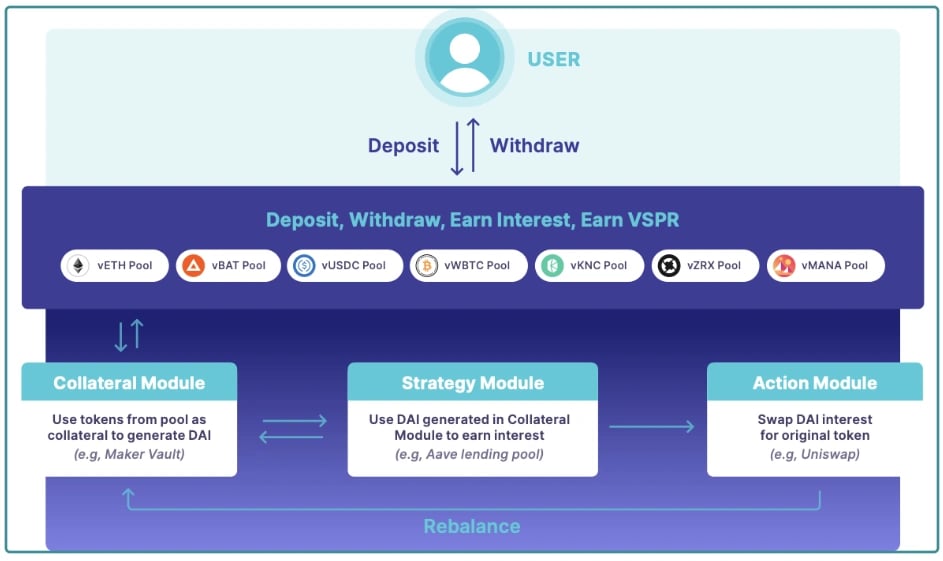
모듈식 멀티풀 접근 방식
베스퍼 풀은 예치 및 인출을 처리하는 프런트엔드 구성 요소와 수익률을 관리 및 집계하는 백엔드 전략으로 구성됩니다. 이러한 설계를 통해 개발자는 다양한 수익률 생성 전략을 만들고 이를 결합하거나 교체하여 더 높은 수익률 기회를 창출할 수 있습니다. 또한 이 아키텍처는 여러 전략의 병렬 실행을 지원하여 다양한 플랫폼에 동시에 대출함으로써 더 나은 수익률 최적화를 제공하는 것을 목표로 합니다. [14]

거버너와 키퍼
베스퍼 풀 스마트 계약에는 "거버너"(Governor)와 하나 이상의 "키퍼"(Keeper)를 포함한 권한이 있는 주소가 포함됩니다. 거버너는 더 중요한 업데이트를 처리하는 반면, 키퍼는 일일 운영 및 풀의 건강을 보장하기 위한 빈번한 업데이트를 관리합니다. 키퍼의 수에는 고정된 제한이 없으며 언제든지 추가하거나 제거할 수 있습니다. 거버너는 계약 실행을 일시 중지하고 주소를 키퍼로 지정할 수 있는 권한을 가지고 있습니다. 키퍼는 전략 가중치를 조정하고 모듈을 업그레이드하여 사용자 경험을 방해하지 않고 지속적인 풀 업그레이드를 가능하게 합니다. [15]
청소
청소는 비네이티브 ERC-20 토큰을 변환하고 담보 모듈에 다시 입금하여 토큰이 계약에 갇히는 것을 방지하는 계약 함수입니다. [16]
베스퍼 전략 (Vesper Strategies)
베스퍼 생태계는 다양한 DeFi 프로토콜과 베스퍼 풀(Vesper Pools)을 연결하는 데 여러 전략을 활용하며, 이러한 플랫폼 간의 광범위한 상호 작용을 조직합니다. 사용자가 풀을 선택하는 동안 사용되는 전략은 풀의 내부 로직에 따라 결정됩니다. 이러한 전략에는 MakerDAO, Aave, Compound, Yearn 등 여러 플랫폼과의 상호 작용이 포함됩니다. [17]
전략에는 중간 위험 또는 고위험으로 분류되는 고유한 위험 수준이 따릅니다. 위험 수준은 기본 계약 상호 작용의 안전성과 관련이 있으며, 중간 위험 전략은 감사된 플랫폼과의 상호 작용이 적습니다. 고위험 전략에는 더 복잡한 상호 작용과 감사되지 않은 계약에 대한 노출이 포함될 수 있습니다. [18]
전략은 주로 대출 청산 가능성과 관련된 손실 발생 가능성에 따라 보수적인 풀 또는 공격적인 풀에 배포될 수 있습니다. 보수적인 풀은 예상치 못한 사건에 대한 보호를 강화하기 위해 더 높은 담보 비율을 가진 전략을 사용합니다. [18]
전략 분류
베스퍼 전략은 핵심 기능과 상호 작용에 따라 다음과 같이 분류됩니다.
- <플랫폼> 예치: 이 기본 전략은 특정 프로토콜에 자산을 예치하는 것을 포함합니다.
- <플랫폼> LP: 이 전략에서는 총 가치 잠금(TVL)이 플랫폼의 관련 유동성 제공(LP) 토큰으로 전환됩니다.
- <플랫폼>에서 <플랫폼>으로: 초기 예치 후, 출력은 다른 플랫폼에 재예치됩니다.
- <플랫폼> 레버리지: 이 방법은 예치된 자산을 담보로 사용하여 동일한 토큰을 반복적으로 빌려 플랫폼에 기여하는 자산을 증폭시킵니다.
- <플랫폼> 차입: 예치금은 다른 토큰을 빌리는 데 담보로 사용되며, 그 후 해당 베스퍼 풀을 통해 라우팅됩니다.
- 베스퍼 프록시: 이 전략은 Earn Pool 전용이며, 예치금을 해당 베스퍼 Grow 풀로 전달하여 처리합니다.[18]
Maker-to-Lending-Platform 전략
이 전략은 MakerDAO(메이커다오)와 Aave(아베) 또는 Compound(컴파운드)를 결합합니다.
- 자산은 담보로 Maker 볼트에 예치됩니다.
- 담보에 대한 DAI 대출이 발생합니다.
- DAI는 수익을 창출하기 위해 Aave(아베) 또는 Compound에 예치됩니다.
- 수익은 공개 시장에서 예치 자산으로 다시 교환되거나 Aave/Compound에 재예치되어 복리 수익을 얻습니다.
이것은 중간 위험 전략이며, 사용되는 담보 기준에 따라 보수적이거나 공격적인 위험 수준을 가질 수 있습니다. [19]
직접 대출 플랫폼
이 전략은 Aave 또는 Compound와 같은 대출 플랫폼에 중개자 없이 자산을 직접 예치하는 것을 포함합니다.
- 풀 자산의 100%를 Aave 또는 Compound에 직접 예치하여 수익률을 극대화합니다.
- 발생한 수익을 청구하고 재예치합니다.
잘 감사된 계약과 보수적인 담보비율을 통해 중간 위험, 보수적인 전략입니다. [20]
Maker-to-Vesper
Maker-to-Vesper는 MakerDAO와 vDAI를 통해 DAI 대출을 활용하여 수익을 창출합니다.
- 자산은 담보로 Maker 볼트에 예치됩니다.
- 담보에 대한 DAI 대출이 발생합니다.
- DAI는 vDAI 풀에 예치됩니다.
- vDAI는 다양한 전략을 활용할 수 있으며, DAI의 특성상 일반적으로 직접 전략을 사용합니다.
이 전략은 담보율과 vDAI를 통해 사용되는 전략에 따라 보수적 또는 공격적으로 구성될 수 있습니다. [21]
VSP 토큰
2021년 2월 17일에 출시된 VSP 토큰은 베스퍼 생태계 내의 유틸리티 및 거버넌스 토큰으로, 사용자가 풀에서 생성된 수익 외에 보상을 얻을 수 있는 기회를 제공합니다. [22]
유틸리티
Vesper 풀을 통한 VSP 획득
사용자는 Vesper 풀에 참여하여 VSP 토큰을 획득할 수 있습니다. 획득하는 VSP의 양은 특정 풀에서 사용자의 지분에 비례합니다. 각 블록마다 일부 VSP가 참여자들에게 배분됩니다. 이 VSP는 사용자가 풀에서 인출할 때까지 스마트 계약에 보관되며, 인출 시 사용자의 주소로 토큰이 전송됩니다. 새로운 풀은 출시 시 인센티브를 제공하여 참여를 더욱 장려합니다. 이러한 VSP 토큰은 풀에서 생성되는 수동적 실질 수익률과 함께 추가 보상으로 제공됩니다. [22][31]
VSP 락업을 통한 esVSP 획득
VSP 토큰을 락업하면 사용자에게 esVSP(ERC-721 토큰)이 제공됩니다. 이는 ETH를 예치하면 vETH가 생성되는 방식과 유사합니다. 풀 내에서 수익 수수료(ETH, BTC, USDC 등 자산)를 회수하고 인출한 후, 이 자금은 Treasury Box로 이동합니다. 이 재무부는 공개 시장에서 VSP 토큰을 매입하는 데 사용되며, 그 후 esVSP 참여자에게 배포됩니다. 이 토큰은 나중에 청구할 수 있습니다. [22][31]
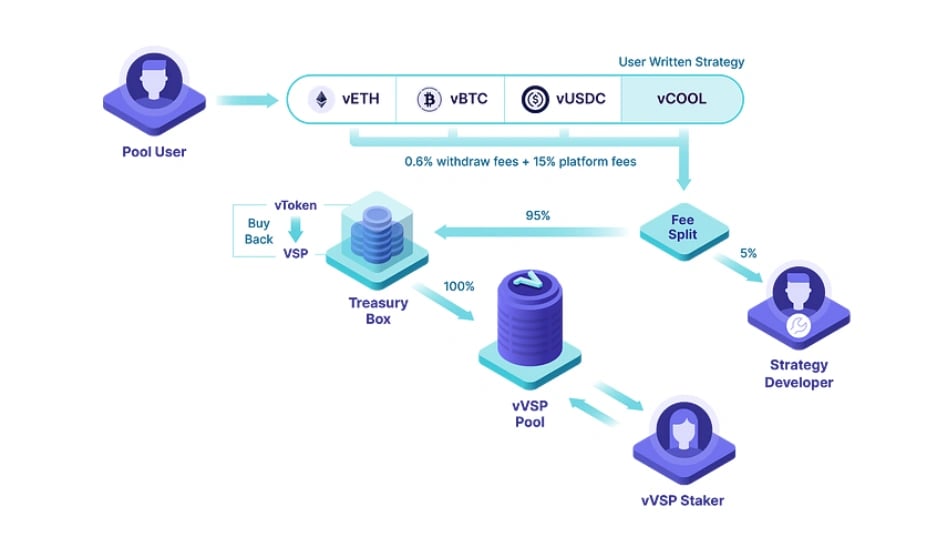
베스퍼 발사 세부 정보
공급 역학
런칭 시점에 베스퍼(Vesper)는 총 10,000,000 VSP를 발행하였으며, 그 내역은 다음과 같습니다.[23]
- 650만 VSP (65%)는 커뮤니티에 할당됩니다. 여기에는 인센티브 출시 풀에 배정된 255만 개, 유동성 제공자를 위한 인센티브 100만 개, 베스퍼 준비금 295만 개가 포함됩니다.
- 350만 VSP (35%)는 베스퍼 팀, 자문위원 및 전략적 파트너를 위해 12개월간의 상장 기간을 거쳐 예약됩니다.
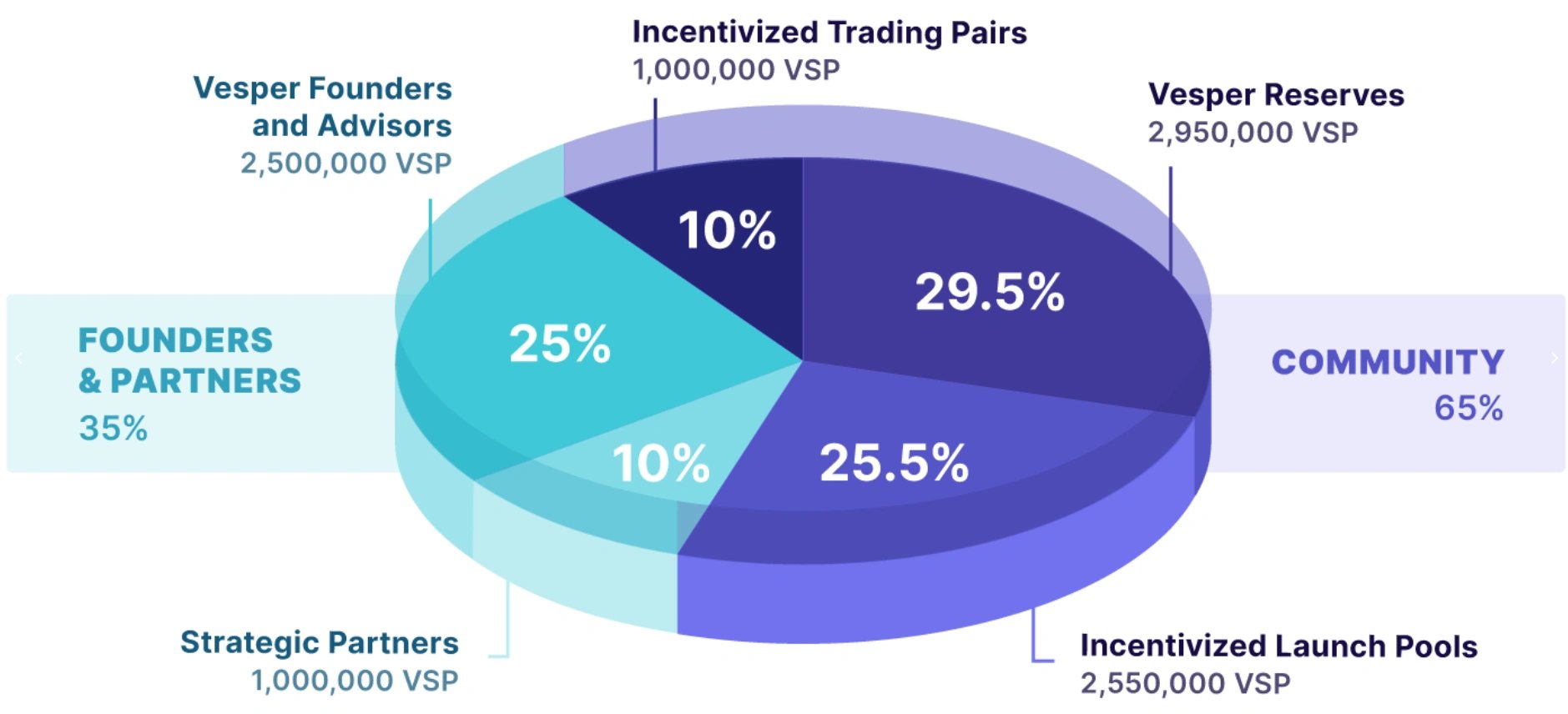
베타 프로그램
공식 Vesper 출시 전 베타 프로그램을 통해 사용자는 자금을 예치하고 초기 Vesper 풀에 참여할 수 있었습니다. 베타 기간 동안에는 활성 VSP 드립이 없었습니다. 대신 전체 기간 동안의 평균 잔액이 기록되었고, 베타 참여자는 베타 종료 후 예치 자산에 비례하는 VSP 토큰을 받았습니다. 초기에는 375,000 VSP로 설정되었던 베타 보상은 총 450,000 VSP로 증가되었으며, Vesper 오픈 베타의 초기 사용자에게 배정되어 별도의 조치 없이 출시일에 에어드롭 형태로 참여자들의 지갑으로 전달되었습니다. [24][25]
토큰 배분
이 배분은 커뮤니티의 재량에 따라 조정될 수 있습니다. 배분 내역은 다음과 같습니다.[26]
- 런치 풀 (2,550,000 VSP): 여기에는 사전 출시 베타 참여자를 위한 450,000 VSP(출시 시 에어드롭)와 12개월에 걸쳐 배포될 2,100,000 VSP(처음 3개월에 상당 부분 집중)가 포함됩니다.
- 리저브 (2,950,000 VSP): 이 리저브는 VSP 투표를 통해 결정될 생태계 성장 및 개발자/커뮤니티 인센티브를 위해 마련되었습니다. 일부 리저브는 Grow Pool의 보상을 높이는 데 활용되었습니다.
- 유동성 제공자 (1,000,000 VSP): Uniswap, SushiSwap, 1inch 및 Loopring(SushiSwap이 대부분을 차지)의 유동성 제공자를 위한 인센티브입니다. 이 배분은 12개월에 걸쳐 이루어지며, 첫 달에 상당 부분 집중됩니다.
- 팀 및 자문위원 (2,500,000 VSP): 이 토큰은 Sablier 계약에 보관되며, 일부는 출시 시 해제되고 나머지는 11개월에 걸쳐 순차적으로 해제됩니다.
- 전략적 파트너 (1,000,000 VSP): 이 토큰의 일부는 출시 시 해제되고, 대부분은 11개월에 걸쳐 순차적으로 해제됩니다.
VSP 배분은 Vesper 풀과 유동성 제공자를 포함한 다양한 참여자에게 배포됩니다. Vesper Pool에 대한 배분은 각 풀의 중요성과 TVL을 반영하는 점수 시스템을 기반으로 합니다. 유동성 제공자의 경우, 유사한 점수 시스템을 사용하여 거래량을 측정합니다. 이러한 지표는 매월 평가되며, 다음 달에 대한 가중치가 그에 따라 업데이트됩니다.[26]
거버넌스
Vesper는 esVSP의 도입과 함께 온체인 거버넌스 모델을 도입했습니다. 이 모델은 수정된 Compound 거버넌스 코드와 Tally.xyz에서 제공하는 사용자 인터페이스를 기반으로 합니다. 거버넌스에 참여하려면 사용자는 esVSP와 교환하여 VSP 토큰을 잠가야 하며, 투표 영향력은 보유한 esVSP의 수량에 따라 달라집니다. 이러한 esVSP 보유자는 가중치 시스템을 기반으로 Vesper 프로토콜 변경 사항을 제안하고 투표할 권한을 갖습니다. [27]
주요 특징
- 장기 사용자에게 수익을 공유하는 보상 제공.
- 사용자가 잠긴 esVSP를 ERC-721 토큰으로 거래할 수 있는 유동적인 거래 가능 포지션 허용.
- 베스퍼 DAO 재무부로 수수료가 지급되는 조기 종료 옵션 구현.[28]
락업
리워드(예: 수익 배분)를 얻으려면 사용자는 VSP 토큰 락업을 시작해야 합니다. 각 esVSP 보유자가 받는 수익은 각각의 가중치에 따라 결정됩니다. 이러한 가중치는 락업된 VSP의 양과 락업 기간(1주일에서 2년(730일)까지)에 따라 달라지며, 최대 4배의 승수가 적용됩니다. [29]
초기 해제
DeFi 내 초기 해제 수수료 개념은 사용자가 생태계에 머물도록 장려하는 안전장치 역할을 합니다. Vesper의 경우, 초기 해제 수수료는 선택한 락업 기간이 끝나기 전에 VSP 토큰을 해제할 때 부과되는 페널티를 나타냅니다. 이 페널티는 50%로 시작하여 시간이 지남에 따라 선형적으로 감소하여 락업 만료 시 0%에 도달합니다. 징수된 모든 페널티 수수료는 Vesper DAO Treasury로 다시 유입됩니다. [30]
수익 모델
유니버설 수수료
베스퍼의 수익 모델에는 유니버설 수수료가 포함되어 있으며, 재조정 시점의 원금 자산에 대해 연 2%의 수수료를 부과합니다. 이 수수료가 발생한 수익의 50%를 초과하는 경우, 수익의 50%와 같도록 조정됩니다. [30]
수익 메커니즘
커뮤니티 풀의 경우, 유니버설 수수료와 유니버설 수익 수수료 모두의 5%가 전략 담당 개발자에게 할당되며, 이 수수료는 풀의 자산으로 지급됩니다. [30]
인센티브
콜래터럴 재조정
사용자는 풀 전체의 시스템 위험을 완화하고 스테이블코인 수익률을 높이기 위해 콜래터럴 재조정(Rebalance-Collateral) 작업을 시작할 수 있습니다. 담보물의 가격이 하한선(Low Water threshold) 아래로 떨어지면 이 작업은 청산을 방지합니다. 반대로, 담보물 가격이 상한선(High Water threshold)을 초과하면 이 작업은 추가 DAI를 생성하여 풀 전체의 수익률을 높입니다. 사용자는 수익률을 극대화하고 청산을 피하기 위해 이 작업을 사용하도록 유도됩니다. [30]
재균형-획득
사용자는 획득한 스테이블코인 이자를 기초 담보로 교환하여 풀의 보유량에 추가하는 재균형-획득 작업을 트리거할 수도 있습니다. 사용자는 이 작업의 시기를 조정하는 데 동기가 부여됩니다. 더 많은 수익을 얻기 위해 작업을 지연할 유인이 있지만, 인출된 담보의 지분을 극대화하기 위해 인출 전에 작업을 수행하도록 권장됩니다. [30]
팀
창립팀
- Jeff Garzik (제프 가르직): 최고 설계자 & 공동 창립자
- Jordan Kruger (조던 크루거): CEO & 공동 창립자
- Matthew Roszak (매슈 로작): 공동 창립자
- Zane Huffman (제인 허프먼): 공동 창립자 & 전략 담당
- Manoj Patidar (마노즈 파티다르): 공동 창립자 & 수석 엔지니어
핵심 팀
- Jelena Keatley (젤레나 키틀리): 마케팅 책임자
- Dean Curran (딘 커런): 마케팅 매니저
- Dominic Mann (도미닉 만): 콘텐츠 매니저
- Jon Greenwood (존 그린우드): 커뮤니티 담당
- Gabriel Montes (가브리엘 몬테스): 블록체인 엔지니어
- Rohit Solia (로히트 솔리아): 스마트 컨트랙트 엔지니어
- Martin Bon Foster (마틴 본 포스터): 자바스크립트 엔지니어
- John Vernaleo (존 버낼리오): 풀 운영 담당
- Nayat Cheikh (나야트 셰이크): 수석 제품 디자이너
- Michael McQuaid (마이클 맥쿼이드): 운영 책임자
자문위원
- 조 왕 (Qiao Wang): DeFi 얼라이언스 공동 설립자 (구 메사리 및 타워 리서치)
- 이안 리 (Ian Lee): IDEO 콜래브 벤처스
대사들
- Cindy Wang (신디 왕): 중국
- Onur Sait Sevim (오누르 사이트 세빔): 터키
- Remy Peretti (레미 페레티): 베트남
- Dziomin Yahor (드지오민 야호르): 러시아/CIS[2]
